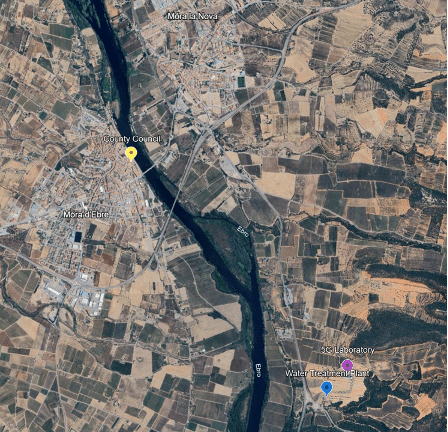
Keep up to date with our innovative initiatives.
Sign up here
The i2CAT Foundation is a research centre founded in 2003 that is committed to designing and building the future digital society by leveraging the knowledge gained from cutting-edge European and local R&D projects in different technological fields. i2CAT collaborates with companies, public administrations, academic institutions, and users to contribute to the definition and structuring of a universal digital innovation system. To make this possible, i2CAT has different initiatives enabling interaction between the quadruple helix: public society, public administration, industry and academia. Due to this long collaboration, i2CAT has testing infrastructure distributed across Catalan geography.
One of these labs, is i2CAT’s Rural 5G Lab, strategically positioned across Mora la Nova and Mora d’Ebre, which serves as a central hub for rural digital innovation. This lab is in a strategically important region in the south of Catalonia, where many activities are done to foster knowledge about and use of state-of-the-art digital technologies. With a focus on 5G connectivity and its multifaceted applications, it serves as a platform to address the pressing challenges of bridging the digital divide, enhancing rural connectivity, and ensuring that even the most remote regions benefit from the technological advancements of the latest digital technologies.
Let’s delve into the technical intricacies of this state-of-the-art facility.
– Primary Site: The main hub (5G laboratory) is Poligon el Molló’s warehouse in Mora la Nova, which is equipped with a data centre, laboratory facilities, and an expansive indoor testing space.
– Secondary Site: The county council of Mora d’Ebre serves as an auxiliary computing facility, housing computing and storage equipment.
– Tertiary Site: Close to the 5G laboratory A local water treatment plant hosts additional computing equipment, a location representing potential landmarks in rural environments that could need digital service and connectivity.
The location of the three sites is shown on the map in Figure 1.

Figure 1: Location of i2CAT’s rural testbed (Google images)
Mora la Nova and Mora d’Ebre are situated in the Tarragona province of Catalonia, Spain. These towns, located within the serene landscapes of the Ebre Valley, offer a vivid representation of rural life in Spain. Serving as a typical example for rural Catalonia, both towns have relatively low population densities, consistent with many rural settings. Mora la Nova and Mora d’Ebre have populations of 3,071 and 5,642, respectively, spread over their territories. This sparse population is typical of many rural regions where communities are scattered and vast expanses of agricultural land dominate.

Figure 2: The Ebro River winding through agricultural fields
Agriculture plays a significant role in the local economy. The Ebro Valley, with its fertile plains, supports a variety of crops. This agrarian backdrop is complemented by tourism, with visitors drawn to the pastoral charm and tranquillity these rural environments offer. The Ebre River, which flows through the region (Figure 2), not only adds to the scenic beauty but also poses unique challenges for technological advancements, especially in wireless communications. The presence of natural barriers, such as rivers and the occasional fog, is typical of many rural areas and offers a real-world environment to test and refine technology solutions. The area where the i2CAT laboratory has been deployed, standing in isolation, further emphasizes the rural character. Such locations, far removed from towns, offer the solitude many rural regions across Spain and Europe are known for.

Figure 3: Testbed overview
Figure 3 depicts the available infrastructure within the i2CAT rural testbed. This includes elements earmarked for the pilot and those reserved for individual technology validations. A snapshot of the available technologies:
– Access Technologies: Cellular 4G/5G and Wi-Fi5.
– Transport Technologies: Millimetrewave backhauling across 60, 70, and 80 GHz spectrums, as well as fibre connection between locations, for control and management.
– Compute Tiers: Both near-edge and far-edge computing tiers are dispersed across two pivotal locations – the warehouse and the regional council.
The standalone 4G/5G cells, both indoor and outdoor, are stationed at the warehouse and complemented by dedicated compute nodes as part of the near edge. The laboratory enjoys robust connectivity to the regional council via a Siklu2 80 GHz point-to-point link, spanning roughly 3.5 km and boasting a capacity of 10 Gbps (full duplex). This council hosts the far-edge computing node. Importantly, both edge compute nodes are interconnected, facilitating service deployment at either location.
In this context, the XGain project arrives as a significant contributor. Its goal is to establish a cost-efficient and eco-friendly technological environment while promoting the integration of modern technologies in rural areas. Taking the 5G rural lab as a starting point, under XGain’s framework, new capabilities will be added to the facilities. In the upcoming phases, the i2CAT rural lab will embark on a drone-based pilot, further pushing the boundaries of technological applications in rural settings. This pilot, leveraging the lab’s robust infrastructure, will showcase the potential of drone technologies and demonstrate the lab’s commitment to continuous innovation. The infrastructure, with its advanced capabilities, serves not merely as a backdrop but as a dynamic play- and testing ground. Here, technologies are not just introduced but are rigorously tested, refined, and optimized, ensuring that the solutions developed are both cutting-edge and tailored for real-world rural challenges. The XGain-related evaluation and pilot activities will be performed during 2024 and 2025.
